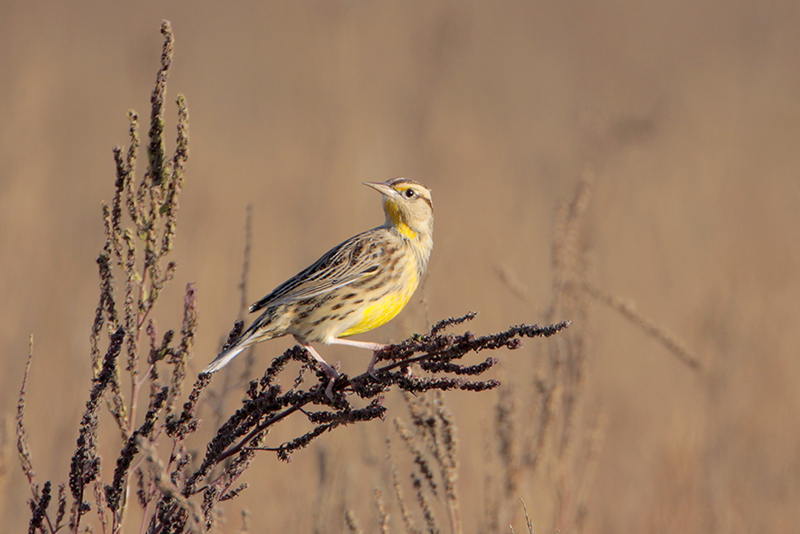
How many birds live in California? More than any other state! The birds of California include an incredible 684 species!
California’s 163,696 square miles of evergreen forest, mountains, wetlands, farmlands, desert, scrublands, and rich coastal waters are a haven for Yellow-billed Magpies, California Quail, California Condors and hundreds of other birds.
Habitat destruction has endangered the Tricolored Blackbird, California Gnatcatcher, and a few other species but most birds in California are still common and easy to see.
We bet you’ve see a lot but with so many possible birds, it can be a challenge to identify everything!
To help, we made an accurate list of the most common birds in California.
On this page
- Most Common Birds of California
- House Finch
- American Crow
- Anna’s Hummingbird
- Black Phoebe
- Mourning Dove
- California Scrub-Jay
- California Towhee
- Yellow-rumped Warbler
- Lesser Goldfinch
- White-crowned Sparrow
- Common Raven
- Song Sparrow
- Turkey Vulture
- Mallard
- Red-tailed Hawk
- Dark-eyed Junco
- Spotted Towhee
- Bushtit
- American Robin
- Northern Mockingbird
- European Starling
- Nuttall’s Woodpecker
- Acorn Woodpecker
- Oak Titmouse
- Canada Goose
- Western Bluebird
- Double-crested Cormorant
- American Coot
- Western Gull
- Northern Flicker
- Great Egret
- Great Blue Heron
- Ruby-crowned Kinglet
- Red-winged Blackbird
- Birds of California – Frequently Asked Questions
Most Common Birds of California
Which birds can we expect to see in California? Hundreds of birds are possible but this list shows the most common wild and backyard birds in the state.
We made it with eBird data and arranged birds from most common to least common. To help identify these common and expected birds of California, we also included information about appearance and behavior.
PS! Just a reminder that the last birds on the list are common too!
House Finch
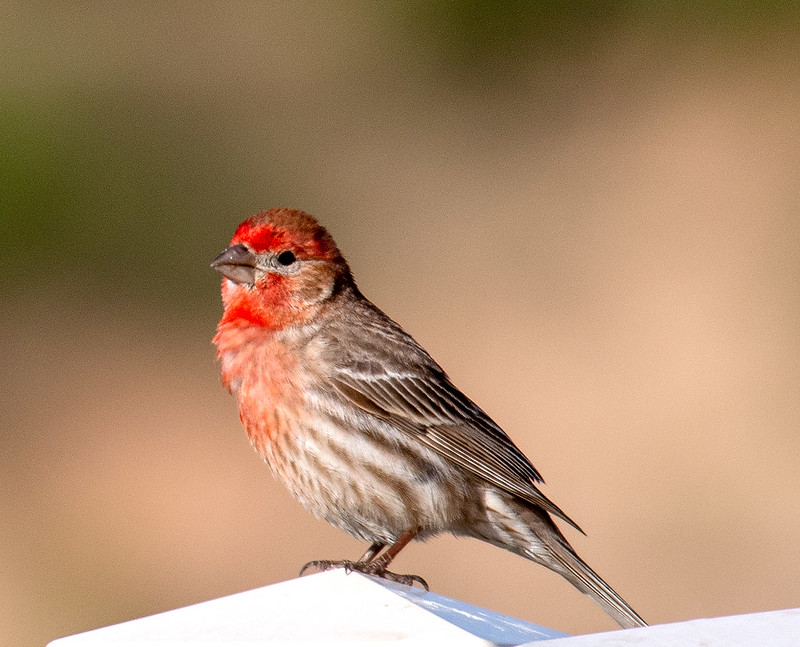
House Finches are some of the most common birds of California. © John Hansen
Scientific name: Haemorhous mexicanus
Length: 6 inches
Weight: .88 ounces
Wingspan: 10 inches
Song: “chip,chip,chiprididip,ZREEYachip”
House Finches are sparrow-sized birds with dark, rounded beaks and fairly long wings. Males are orange-red or rose-red on their head, throat and breast, and have some red on their rump. They also have brownish streaks on their back, flanks, and white belly.
Like the male, female House Finches have two white wing bars on long, gray-brown wings. However, they lack red and are mostly streaked, dull brown-gray birds.
House Finches feed on seeds, buds, fruit, and flowers. They often visit feeders in California, but also forage on the ground, and in bushes and trees.
We see these pretty birds in deserts and arid zones and in parks, farmland, urban areas, and other semi-open habitats.
The House Finch makes a soft cup nest built on a tree, building ledge or other spot with some overhanging cover. They often occur in small groups and live in southern Canada, most of the USA, Mexico, and Hawaii.
Key Identifications:
- Reddish or plain gray-brown, streaked, sparrow-like bird.
- Eats seeds, flowers, buds, and fruit. Can visit feeders but also forages on the ground and in bushes and trees.
- Makes a soft cup nest in trees, on building ledges, and in other places.
- The House Finch often makes a soft, “fidip” call. Males also sing a warbling song from prominent, high perches. It sounds like, “chip,chip,chiprididip,ZREEYachip”.
House Finches are sparrow-like, reddish or brownish, streaked birds. They live in arid zones as well as in parks and urban areas. All of the millions of House Finches that live east of the Rocky Mountains are descendants of birds released on Long Island in 1939.
American Crow

© Alan D. Wilson
Scientific name: Corvus brachyrhynchos
Length: 17.5 inches
Weight: 1 pound
Wingspan: 39 inches
Song: “Caw! Caw!”
The American Crow is a big, all black bird with a strong, stout bill. In certain lighting, it can have metallic purple and blue iridescence.
Both sexes look the same and have some feathering on their beaks, long, broad wings, and a broad tail.
American Crows have a direct flight with strong, steady wing beats. Crows are very social and intelligent birds that are usually seen in flocks. They forage together on the ground or in trees and eat just about anything they can find.
Some of their more regular foods include carrion, fruit, nuts, seeds, insects, and small animals. Like most jays and crow species, they also eat the eggs and nestlings of other bird species.
This species builds bulky stick nests high in trees and lives in most habitats except for high mountains and arid zones.
The American Crow occurs in southern Alaska and much of Canada and the USA.
Key Identifications:
- Big, all black bird with long, broad wing and a broad tail.
- Forages for carrion, fruit, seeds, insects, and small animals.
- Builds a bulky stick nest high in a tree.
- American Crows are very vocal birds. They can make several calls but their most common one is, “Caw! Caw! Caw!”
American Crows usually occur in flocks and live in all sorts of places, even urban zones. These birds are very smart and have funerals or wakes! When a crow dies, other crows mark the occasion by gathering together and loudly calling.
Anna’s Hummingbird
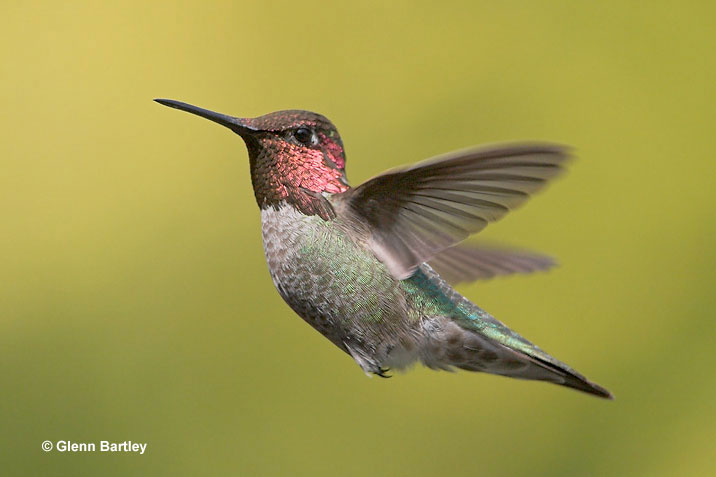
Scientific name: Calypte anna
Length: 4 inches
Weight: .15 ounces
Wingspan: 5.25 inches
Song: “zree zree zee zree”
The Anna’s Hummingbird is a small bird with a needle-like beak, green back, and green underparts with some gray markings. The male has glittering dark pink on his crown and throat, while the female lacks these colors. Instead, she has small green spots on her throat and some black and white in her tail.
Both sexes have a small white spot behind each eye.
Like other hummingbird species, Anna’s Hummingbirds feed on nectar from flowers and also catch tiny insects in flight. It feeds from a variety of flowering bushes and other plants and visits hummingbird feeders.
This species makes a tiny cup nest out of spider webs and soft vegetation. It builds its nest in a variety of trees, bushes, and vines.
The Anna’s Hummingbird lives in brushy habitats and gardens from southern British Columbia to Arizona. Most birds are permanent residents but some winter in northwestern Mexico.
Key Identifications:
- Small green hummingbird with a straight beak, grayish-green underparts, and white spot behind the eye. The male has dark pink on his head and throat.
- Feeds on small flying insects and nectar.
- Makes a small cup nest out of spider webs and soft vegetation.
- Makes dry and scratchy sounds, “zree zree zee zree”.
The Anna’s Hummingbird is a small gray-green hummingbird of gardens and brushy habitats on the Pacific coast. They feed on insects and nectar and often visit feeders. Urban gardens have helped this species expand north from California to Washington and British Columbia.
Black Phoebe
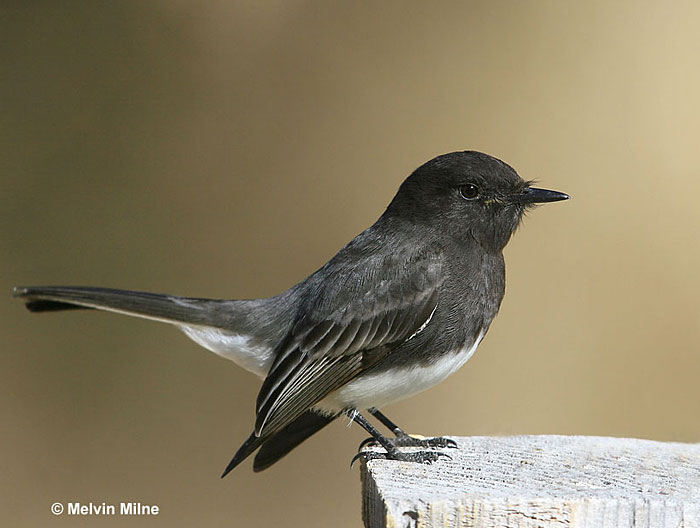
Scientific name: Sayornis nigricans
Length: 7 inches
Weight: .67 ounces
Wingspan: 11 inches
Song: “peet syeh peet syeh peet syeh”
The Black Phoebe is a medium-sized black and white flycatcher with a small crest. This species is easily recognized by its black plumage with white belly.
Males and females look alike and have a slender black bill, and white edging in the feathers of their wings and tail.
The Black Phoebe likes to sit on a low perch above or near a stream and fly out to catch insects in the air and on the ground. On occasion, it also eats berries and even small fish.
This species uses grass and mud to make a cup nest under a bridge, on a rock wall, or other hard structures. It usually builds its nest over or next to a stream.
Black Phoebes live along streams and near other waterways in open and wooded habitats. They range from parts of southwestern Oregon through California and in Arizona, New Mexico, and in western Texas.
Key Identifications:
- Thrush-sized black and white flycatcher with a short crest.
- Flies from a perch to catch insects in flight and on the ground.
- Makes a cup nest out of mud and grass, under a bridge or on another hard structure.
- Makes high-pitched calls and sings, “peet syeh peet syeh peet syeh”.
The Black Phoebe is a thrush-sized black and white flycatcher with a small crest. They live near streams or other water features in open and wooded habitats. This species is one of the few black and white flycatchers in the world and the only one in North America.
Mourning Dove
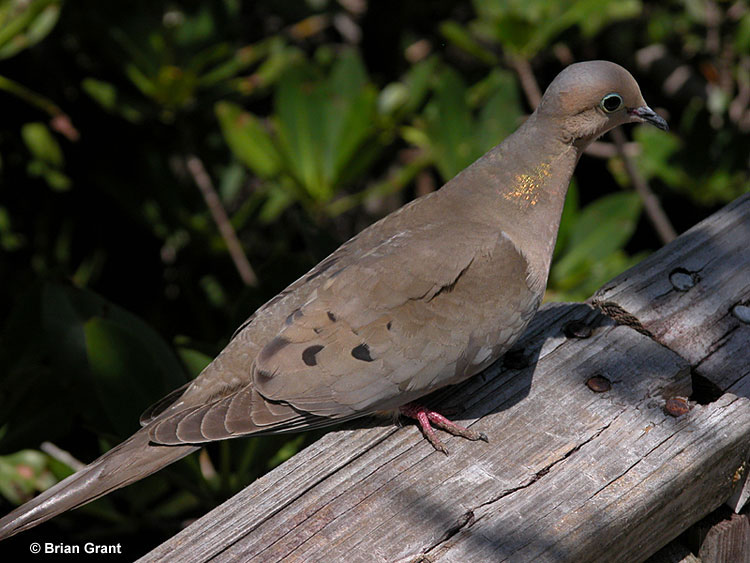
Scientific name: Zenaida macroura
Length: 12 inches
Weight: 4.2 ounces
Wingspan: 18 inches
Song: “hooOOA, hoo, hoo, hoo”
Mourning Doves are medium-sized, grayish-brown doves with long tails. They have small black spots on their wings and a small head with a slender, dark beak.
Males and females also have narrow gray eyerings, a black mark on the face, and pale iridescent gold on the sides of their necks. They look alike except for males having more gray on the head and neck, and more iridescence.
This dove has fairly long wings and swift, direct flight. When flying, it shows black and white on its tail.
The Mourning Dove occurs in woodlands, gardens, on farms, and in urban areas. This common feeder visitor eats seeds and grains. It also forages in open situations, picking food from the ground.
This pleasant dove species can visit a feeder on its own or forage in small flocks. It builds an unkempt stick nest in bushes and trees and is very common throughout the USA, southern Canada, and Mexico.
Key Identifications:
- Plain brown and gray dove with a long, pointed tail.
- Feeds on seeds at feeders and on the ground in open areas.
- Makes a small, messy nest of sticks in trees.
- Sings a sad and owl-like “hooOOA, hoo, hoo, hoo”.
The Mourning Dove is the common garden dove in most of its range. It often visits feeders and its cooing song is commonly mistake for an owl. This species has a short lifespan with many adults only living for a couple of years or less.
California Scrub-Jay
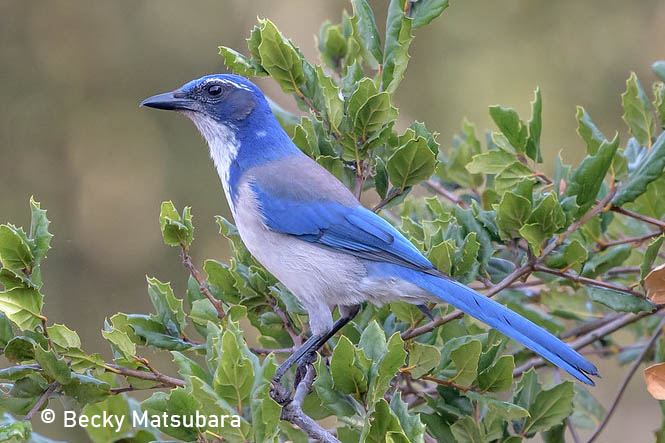
Californian Scrub Jay © Becky Matsubara (Flickr) https://flickr.com/photos/beckymatsubara/
Scientific name: Aphelocoma californica
Length: 11.5 inches
Weight: 3 ounces
Wingspan: 15.5 inches
Song: “reeht! reeht reeht!”
The California Scrub-Jay is a fair-sized jay with a white throat that is mostly blue above and pale gray below. Both sexes look alike and have a narrow white eyebrow, gray back, and dark face.
They occur in small, noisy groups that forage for a variety of food items in open and brushy habitats. These jays use their stout, slightly hooked beaks to eat acorns, insects, caterpillars, nestlings of other birds, and other small animals.
California Scrub-Jays also pick ticks from the back of deer as they perch on the large animal’s back.
This species uses twigs and other bits of plants to make a bulky, open cup-shaped nest in low trees and bushes.
The California Scrub-Jay is especially common in dry, oak, and oak-pine woodlands in lower elevations.
We also find them in gardens, brushy areas, riparian zones, and other habitats from western Washington south to California and Baja California.
Key Identifications:
- Medium to large jay with a white throat that is blue and gray above and pale gray below.
- Feeds on insects, acorns, small animals, and other food items. Also visits feeders.
- Makes an open, bulky cup nest out of twigs and sticks.
- This species is vocal, often making a nasal call, “reeht! reeht reeht!”.
The California Scrub-Jay is a fairly large jay that is blue above and pale below. This social bird looks for acorns and a variety of food items in gardens, oak woodlands, and other habitats. The hooked bill of this intelligent species helps it pick up and eat acorns.
California Towhee
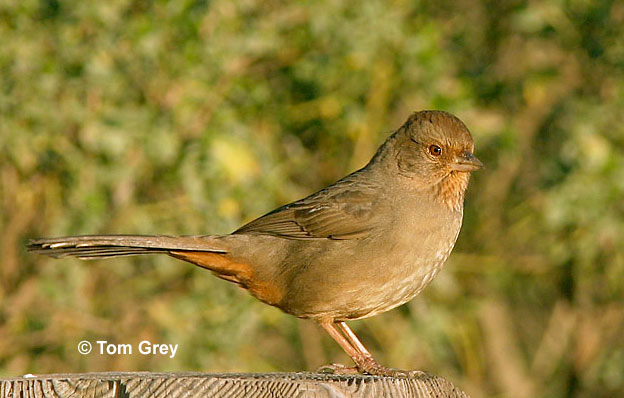
Scientific name: Melozone crissalis
Length: 9 inches
Weight: 1.5 ounces
Wingspan: 11.5 inches
Song: “chip dipdidididip chiput”
The California Towhee is a plain, brown-gray bird nearly the same size as an American Robin. Males and females look alike and have a grayish, finch-like beak, and russet-brown on the throat, face, and around their eyes.
They also have russet-brown under their longish tail, pinkish legs, and rounded wings. These terrestrial birds prefer to hop on the ground but also make brief and quick flights between bushes.
This species eats a variety of small seeds and some insects. It forages on the ground, often scratching leaf litter with both feet and picking food from the ground and low vegetation. However, this towhee is also regular at feeders and, in many areas, is a common garden bird.
California Towhees use grass and other vegetation to make cup nests in dense shrubs and low trees.
This species lives in brushy areas, semi-open woodlands, and riparian zones in parts of southern Oregon, western and central California, and Caja California.
Key Identifications:
- Plain brown-gray bird with russet-brown under its tail and on its throat and face.
- Forages for seeds on the ground and also visits feeders.
- Makes a cup nest in a dense shrub or low tree.
- Makes sharp chip notes and has a high-pitched song, “chip dipdidididip chiput.”
The California Towhee is a plain, brown-gray bird with a longish tail. They usually occur in pairs that forage on the ground and visit feeders in gardens and in semi-open and brushy habitats. Habitat destruction caused by feral donkeys threatens an isolated subspecies of California Towhee restricted to the Argus Mountains of Inyo County.
Yellow-rumped Warbler
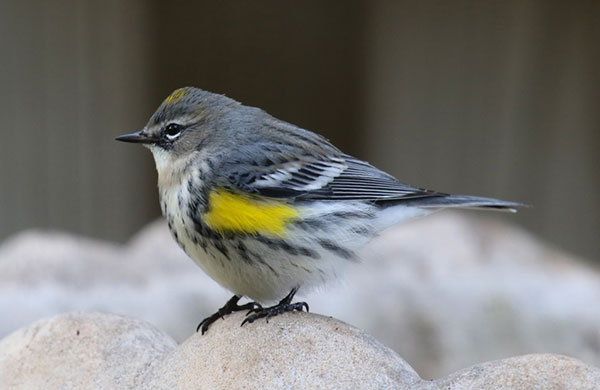
Scientific name: Setophaga coronata
Length: 5.5 inches
Weight: .42 ounces
Wingspan: 9.25 inches
Song: “si,sit,sit,sit,sit,sue,sue,sue”
The Yellow-rumped Warbler is a small, blue-gray songbird with a yellow rump, crown, and yellow patches on each side of its breast. It also has two white wing bars, dark marks on the back, and white underparts with blackish markings on its breast and sides.
In summer, this species has a blackish face and white markings above and below the eyes. Females are like males but duller. In winter, both sexes of Yellow-rumped Warblers are duller and have more brownish plumage.
The western subspecies have a yellow throat and more white in the wings.
This species feeds on insects and small berries. It picks food from vegetation and briefly flies into the air to catch bugs in flight.
Yellow-rumped Warbler build small cup-shaped nests in conifers in Canada and the northeastern and western USA. They spend the winter in semi-open habitats from the southern USA to Central America.
Key Identifications:
- Small songbird with two pale wing bars and yellow patches on the rump, each side of its breast, and crown.
- Feeds on insects and small berries.
- Builds cup nests in conifers in northern and montane forests.
- The Yellow-rumped Warbler makes a sharp call note, “chup!”, and sings a brief and easy-going warbling song, “si,sit,sit,sit,sit,sue,sue,sue.”
Yellow-rumped Warblers are small, blue-gray or brownish songbirds with two pale wing bars, and yellow patches on the crown, sides of the breast, and rump. In winter, they occur in small flocks that feed on insects and berries in parks and other semi-open habitats. The eastern subspecies is known as the “Myrtle Warbler” and the yellow-throated western subspecies is called, “Audubon’s Warbler”.
Lesser Goldfinch
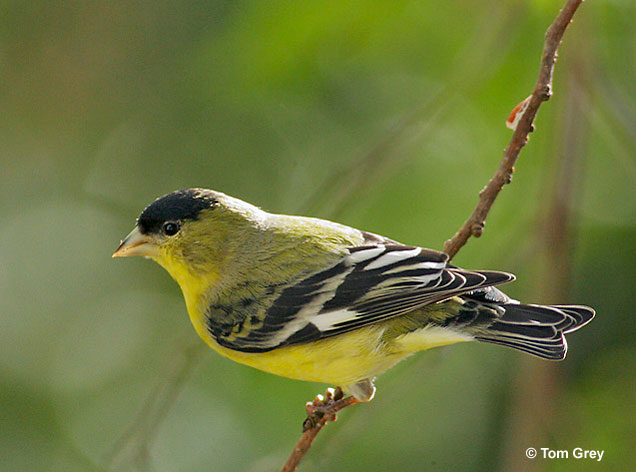
Scientific name: Carduelis psaltria
Length: 4.5 inches
Weight: .3 ounces
Wingspan: 8 inches
Song: “chip idid see sipachupchipchipasipsipchipadip”
The Lesser Goldfinch is a small bird with a grayish, finch-like beak, rather short, forked tail, and long blackish wings with white markings.
Males have a black cap, olive gray-green upperparts, and yellow underparts. Birds that live east of the Rockies have completely black backs. Females are much plainer and are pale brown-olive above and yellow below.
Lesser Goldfinches have quick, bounding flight. They can occur as pairs but, in California and the American southwest, often form sizeable flocks.
This species feeds on a variety of seeds. They often occur in groups with other seed-eating birds as they forage in weedy fields and visit feeders. Lesser Goldfinches pick up seeds from the ground and while perched on stalks of grass-like plants.
The Lesser Goldfinch uses plant fibers to make a small cup nest in a tree.
This species lives in brushy and semi-open woodlands in Texas and the American southwest north to southern Washington.
Key Identifications:
- Small finch with olive or black upperparts, yellow underparts, a dark beak, and a small white patch in the wing.
- Forages for seeds on and near the ground and also visits feeders.
- Makes a small cup nest out of grass and other plant matter.
- This species makes clear, high-pitched calls and has a jumbling, tinkling song with warbled and trilled notes, “chip idid see sipachupchipchipasipsipchipadip”.
Lesser Goldfinches can be found in brushy habitats and open woodlands, visits feeders, and is one of the most common birds of California. This species waits for thistle and plenty of other “weedy” plants to have seeds before it builds its nest.
White-crowned Sparrow
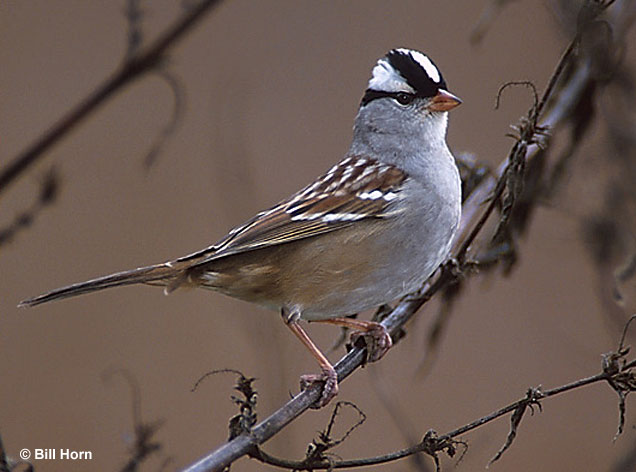
Scientific name: Zonotrichia leucophrys
Length: 7 inches
Weight: 1 ounce
Wingspan: 9.5 inches
Song: “tuuur teeteetee zhree zhree zeh”
The White-crowned Sparrow is a thrush-sized sparrow with black and white stripes on its head and a small, finch-like orange or pinkish beak.
Both sexes look alike and have a gray face, gray underparts with pale brown flanks, streaked brown back, and gray-brown rump. Their rounded wings are mottled brown with two pale wing bars.
In winter, young birds have brown and tan stripes on their head.
The White-crowned Sparrow feeds on insects, seeds, grass, buds, and fruit. It forages by picking food items from the ground and in low vegetation. In winter, this species moves around forest and park-like habitats in flocks.
This sparrow makes a cup nest out of grass, bark strips, and other plant matter and builds it on the ground or in a low bush.
White-crowned Sparrows occur in shrubby habitats in Alaska, Canada, the Rocky Mountains, along the Pacific Coast, and winter in much of the western, central, and eastern USA.
Key Identifications:
- Thrush-sized sparrow with a black and white striped head, gray underparts, orange or pinkish finch-like beak, and two wing bars.
- Eats insects, seeds, and fruit on and near the ground, often in flocks.
- Makes a cup nest on or near the ground.
- Makes a sharp call, “Pick!” and sings a pleasant song, “tuuur teeteetee zhree zhree zeh”.
The White-crowned Sparrow is a fairly large sparrow with black and white stripes on its head. Young birds have brown and tan striped heads and this species occurs in flocks in the winter. Some White-crowned Sparrows are “bilingual” as they learn more than one regional song.
Common Raven
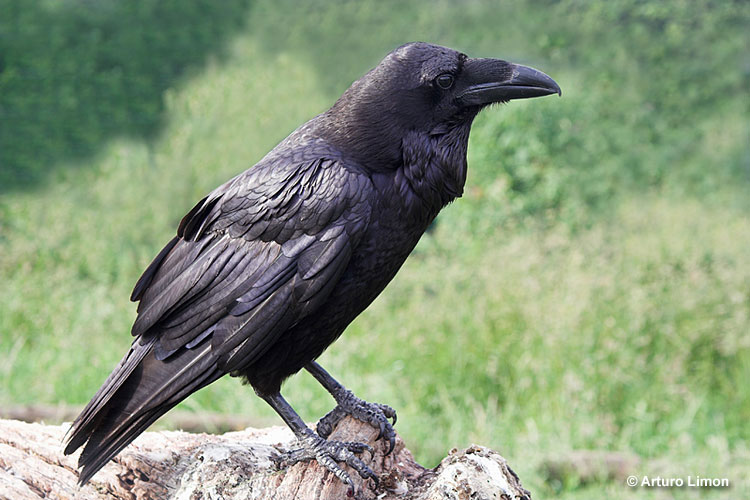
Scientific name: Corvus corax
Length: 24 inches
Weight: 2.6 pounds
Wingspan: 53 inches
Song: “Grauk Grauk Grauk Grauk!”
The Common Raven is a big, black crow-like bird with long, broad wings and a broad, wedge-shaped tail.
Both sexes look alike and have feathers extending onto the top part of their strong, stout beaks.
This bird is often seen in soaring flight or in direct flight, where it gives a few strong flaps between glides.
Common Ravens are omnivores that feed on carrion, small animals, nesting birds, and various other food items. They forage by flying above roads and other places and are always on the lookout for feeding opportunities.
This big Corvid makes a big, bulky nest out of sticks and lines the shallow cup with mud, wool, and other items. It builds its nest on a cliff, tree, bridge, or other structure.
The Common Raven lives in wilderness areas from the Arctic to parts of the northeastern USA and the western USA. In some places, it lives in urban areas.
Key Identifications:
- Huge, black, crow-like bird with a strong, stout beak and a wedge-shaped tail.
- An omnivore that feeds on small animals, carrion, and other food items.
- Makes a big bulky stick nest in trees, on cliffs, and on human-made structures.
- Common Ravens are vocal birds. One of their most common calls is a load and croaking, “Grauk Grauk Grauk Grauk!”.
The Common Raven is a large, black, crow-like bird of mountains, forest, tundra, and other wild areas. Some also live near people and in flight, they can sometimes be mistaken for raptors. However, no hawk species is entirely black with a wedge-shaped tail. The Common Raven can mimic human speech and is one of the most intelligent bird species.
Song Sparrow
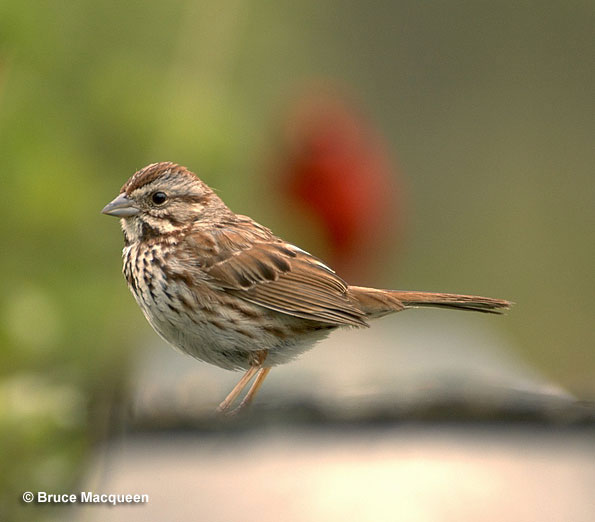
Scientific name: Melospiza melodia
Length: 6.25 inches
Weight: .7 ounces
Wingspan: 8.25 inches
Song: “seet serate sitsziziziziziziziz seet”
The Song Sparrow is a small, gray and brown, streaked songbird with a thick dark mark on each side of its white throat. Males and females look the same and have white underparts with a dark brown mark on their breast, and dark brown streaks on their breast and sides.
Most Song Sparrows also have two narrow wing bars and show a rounded tail when fluttering between bushes.
This species feeds on insects, seeds, and small fruits. Pairs forage by picking up food items on and near the ground. They are also frequent visitors to bird feeders.
Song Sparrows use grass, stems, hair, and other materials to make a cup nest placed on or near the ground. They nest in dense vegetation, shrubbery, or low trees, often near water.
This species uses a wide variety of brushy habitats in open and wooded situations in southern Alaska, most of Canada, and all of the USA.
Key Identifications:
- Small brown, streaked sparrow with a dark mark on its breast.
- Forages on and near the ground for seeds and insects in brushy habitats.
- Builds a cup nest on or near the ground in a shrub or low tree.
- Makes high-pitched “tink”, chirping calls, and has a cheerful song with a trill, “seet serate sitsziziziziziziziz seet.”
Song Sparrows are reddish-brown songbirds with dark brown streaks and a dark brown breast patch on white underparts. They usually occur in pairs and are often heard and seen in brushy areas and large gardens. There are several subspecies with distinct plumages, including a large, dark one that lives on the Aleutian Islands.
Turkey Vulture
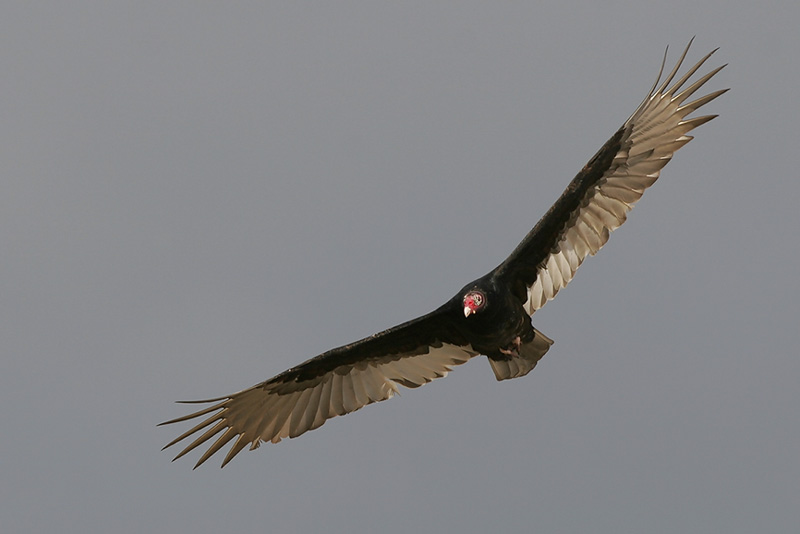
Scientific name: Cathartes aura
Length: 26 inches
Weight: 4 pounds
Wingspan: 67 inches
Song: “hisss”
The Turkey Vulture is a big, dark brownish-black raptor with a small red head and long, broad wings. Males and females look alike and also have a longish tail.
In flight, the way Turkey Vultures soar is one of the best ways to recognize them. They fly with their wings held in a “V” shape and, when gliding, often rock back and forth.
Their flight feathers are also paler than the rest of their wings, but they lack the Black Vulture’s white wing patch.
Turkey Vultures are scavengers, and most of their diet is carrion. They eat road kill and a wide variety of dead animals. This species forages over every type of habitat and can also fly over urban areas.
It lays two eggs on the ground in caves and hollow logs.
The Turkey Vulture lives in southern Canada and in most of the USA south to southern Argentina.
Key Identifications:
- Big, dark raptor with a small red head that soars with long wings held in a “V”.
- Feeds on dead animals.
- Nests on the ground in caves and hollow logs in secluded areas.
- Turkey Vultures rarely call and mostly make hissing sounds at their nest.
The Turkey Vulture is commonly seen flying over every type of habitat. They are often seen on their own but can occur in flocks, especially during migration. Unlike most other birds, this species uses its amazing sense of smell to find dead animals.
Mallard
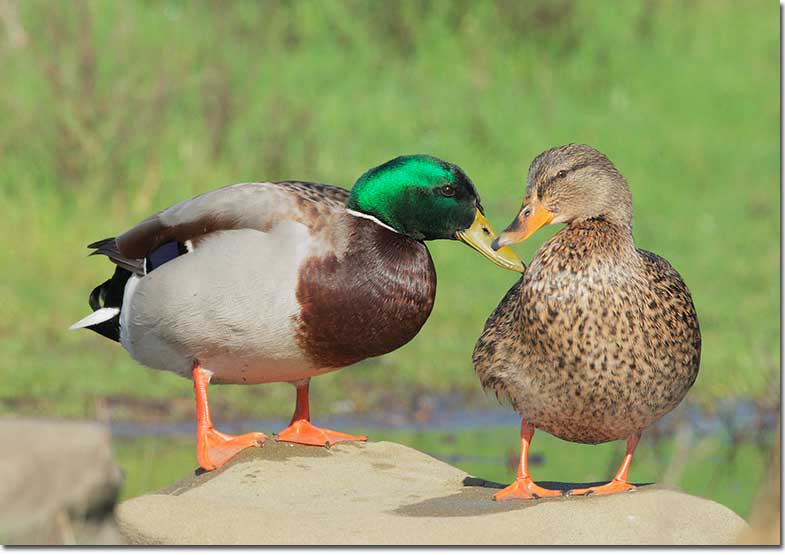
Mallard pair (Male and female)
Scientific name: Anas platyrhynchos
Length: 23 inches
Weight: 2.4 pounds
Wingspan: 35 inches
Song: “quack, quack”
The Mallard is a fairly large, familiar duck. The male has a metallic green head, yellow bill, narrow white ring around the neck, and chestnut breast. The rest of the bird is pale gray with pale brown, and black on its back and around his tail.
Female Mallards are mottled brown and buff with a dark crown and line through the eyes and have a dark gray and orange beak.
In flight, both sexes show a green-blue wing patch bordered with white.
Mallards eat a variety of items, including insect larvae, snails, other small aquatic creatures, acorns, seeds, and grain. They forage by filtering and picking up food items in and near shallow water and in farm fields.
This Californian duck species makes a shallow nest with sticks and lined with down feathers. It builds its nest on the ground, hidden in grass or under a bush.
The Mallard lives in ponds, marshes, and many wetland habitats in Canada, USA, and Eurasia. They are one of the most common birds of California.
Key Identifications:
- Feeds on insect larvae, grain, seeds, and other items picked up with its bill in and near shallow water.
- Makes a shallow stick nest hidden in grass or under a bush.
- The female Mallard makes the classic “quack, quack” duck sound. Males make similar but softer sounds and a whistling call.
The Mallard is a fairly large and familiar duck with a dark green head (the male), or is buff and brown with a dark gray and orange beak (the female). Thus duck species often lives near people and occurs on lakes, ponds, and other wetlands. No matter how different they look, most small domestic duck species are descended from wild Mallards.
Red-tailed Hawk
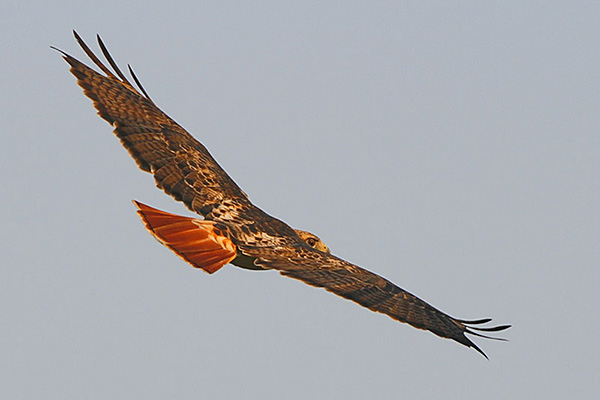
Scientific name: Buteo jamaicensis
Length: 19 inches
Weight: 2.4 pounds
Wingspan: 49 inches
Song: “Kreeeyahh!”
The Red-tailed Hawk is a large and chunky raptor with a broad, orange or reddish tail. Males and females look alike, although females are larger.
These raptors are dark brown above and are pale below, with dark markings on their belly. Young birds are more streaked on their underparts, and have brown tails with dark barring.
Red-tailed Hawks often soar and have long, broad wings that can show pale square patches on the bases of their primaries. While soaring, they watch for squirrels and other small animals that they feed on.
When they spot prey, these big birds drop down to catch it with their talons. This hawk also hunts by watching for prey from a perch.
Related: Most Common Hawk Species in California
The Red-tailed Hawk builds a large, bulky, stick nest high in trees. They thrive in a wide variety of habitats but especially in woodlands near fields and other open habitats.
This raptor lives from Alaska and Canada south to Central America.
Key Identifications:
- Large, bulky hawk with a broad, reddish tail.
- Catches squirrels, rats, pigeons, and many other small animals on the ground.
- Nests in large, bulky nests made of sticks.
- A vocal raptor, Red-tailed Hawks often call in flight. They usually give a “classic” but quiet-sounding raptor scream, “Kreeeyahh!”
Red-tailed Hawks are large dark brown and pale hawks with broad, reddish tails. The most common raptor in many areas, they often perch on powerline poles along roads. The Red-tailed Hawk’s vision is eight times better than a person’s; they can spot a tiny rodent while soaring 100 feet above it.
Dark-eyed Junco
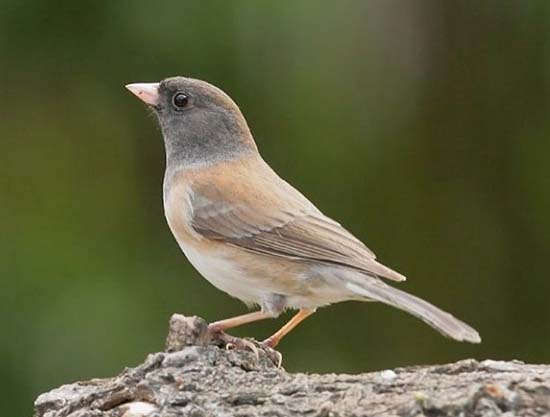
Scientific name: Junco hyemalis
Length: 6.25 inches
Weight: .67 ounces
Wingspan: 9.25 inches
Song: “sipsipsipsipsipsipsip”
Dark-eyed Juncos are sparrow-like birds with pale conical bills and dark eyes. This small bird has variable plumage, with most being slate gray or gray and brown with white on their bellies and white under their tails.
Other plumages include birds with dark masks and faint white wing bars, juncos with pale gray hoods and pinkish sides, and birds with blackish hoods and chestnut sides.
In flight, all Dark-eyed Juncos show extensive white in their longish tails.
This species feeds on seeds, insects, and some fruit and grain. Juncos forage on the ground in wooded areas, parks, and other habitats. They also feed on fallen seeds beneath feeders.
They build cup nests on the ground under fallen logs, in roots, and in other hidden spots. After breeding, juncos form flocks that forage together in similar wooded and semi-open habitats.
Dark-eyed Juncos are common birds in Canada, the USA, and parts of Mexico.
Key Identifications:
- Sparrow-like gray and brown bird with dark eyes, a pale beak, and white in the tail.
- Forages for seeds and insects on the ground, can feed on seeds at and beneath feeders.
- Builds a cup-shaped nest on the ground in tree roots, under logs, and other hidden places.
- This species often makes a sharp, high-pitched chip note, “pik!”. On breeding grounds, males sing a short, plain trill, “sipsipsipsipsipsipsip.”
Dark-eyed Juncos are sparrow-like, gray and brown birds with much white in the tail. Common wintering birds in many areas, they forage for seeds on the ground in wooded and park-like habitats. In many places, this common species is also known as the “Snowbird” on account of only occurring in the winter months and having white on the belly and tail.
Spotted Towhee
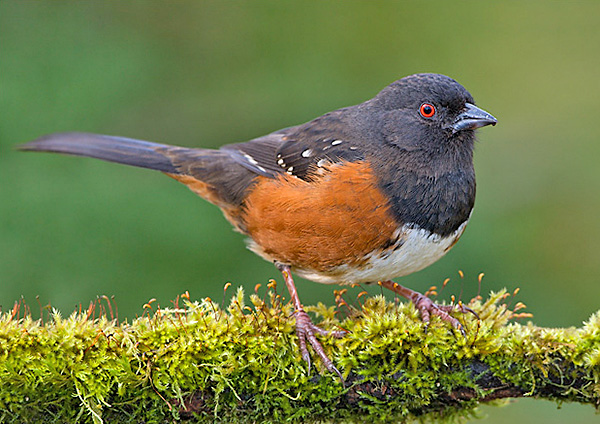
Photograph © Glenn Bartley.
Scientific name: Pipilo maculatus
Length: 8.5 inches
Weight: 1.4 ounces
Wingspan: 10.5 inches
Song: “two two two chreee!”
The Spotted Towhee is a thrush-sized, colorful, sparrow-like bird with reddish eyes and a black, finch-like beak. It has black upperparts with some small white spots, a black hood, and a white belly with chestnut flanks.
It also has a buff undertail and white spots on the underside of its longish, rounded tail. Both sexes look similar but the female has a grayish-brown head. Juveniles are like dark brown, streaked sparrows with white in their tails, two buff wing bars, and a buff undertail.
Spotted Towhees find insects and seeds by using both feet to scratch and toss leaf litter. This bird also eats berries in bushes, especially in winter.
This species makes an open cup nest out of grass and other plant matter in dense vegetation near or on the ground.
The Spotted Towhee lives in shrubby habitats from Manitoba and the Dakotas west to the coast. In winter, they range east to Kansas and south to Texas.
Key Identifications:
- Medium-sized, colorful songbird with a black hood, white spotting on black upperparts, and chestnut flanks.
- Forages on the ground for insects and seeds in leaf litter in shrubby habitats.
- Makes an open cup nest in dense vegetation, on or near the ground.
- Often calls and makes a nasal, cat-like call, “rheyeah,” and sings a short trilled song, “two two two chreee!”
Spotted Towhees are thrush-sized black and white birds with chestnut flanks and white spotting on their wings and/or back. They occur in pairs that forage for insects and seeds in leaf litter. When female Spotted Towhees are disturbed on their nests, instead of flying away, they distract predators by running away.
Bushtit
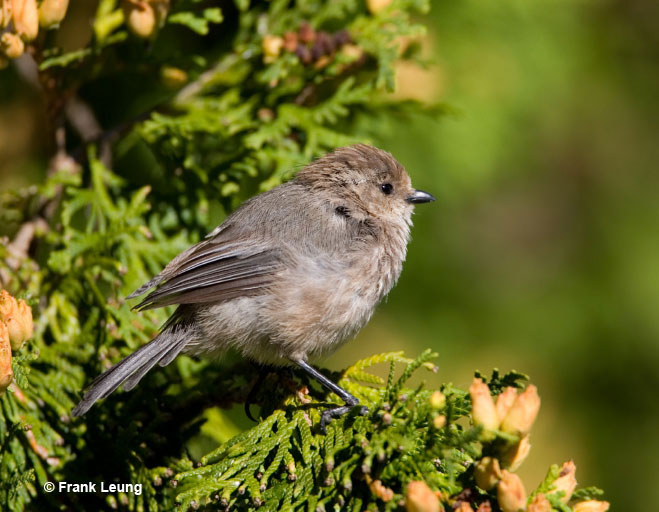
Scientific name: Psaltriparus minimus
Length: 4.5 inches
Weight: .19 ounces
Wingspan: 6 inches
Song: “peeseesee seesee seeseesee”
The Bushtit is a tiny, plain gray bird with pale buff underparts, longish tail, and stubby black beak. On the Pacific coast, they have some brown on their crown, while Bushtits in other areas have gray heads.
Males have dark eyes, while females have pale eyes. Bushtits from Texas south to Guatemala have black on their face.
This species feeds on small insects and spiders. Flocks forage together and with other species by busily moving through vegetation and picking food from foliage and twigs. They are quite acrobatic and often hang upside down while feeding.
Bushtits use spider webs and plant matter to make a hanging pendulum nest with an entrance hole near the top. They build their nests in a variety of bushes and trees.
The Bushtit lives in semi-open shrubby, and wooded habitats with evergreens. It occurs in southeastern British Columbia, and various parts of the western USA and Texas south to Guatemala. Bushtits are one of the most common birds of California.
Key Identifications:
- Tiny, plain, gray and buff birds with a longish tail and a stubby, black beak.
- Forages for small insects and other arthropods in semi-open, wooded and brushy habitats.
- Makes a small hanging nest out of spider webs and plant matter.
- This cute bird makes repeated high-pitched sounds, “peeseesee seesee seeseesee”.
The Bushtit is a tiny, plain grayish bird with a short, stubby beak. They are very social and forage together in a variety of brushy and open wooded habitats. Unlike many other bird species, several adult males can cooperate to help feed nestlings at the same nest.
American Robin
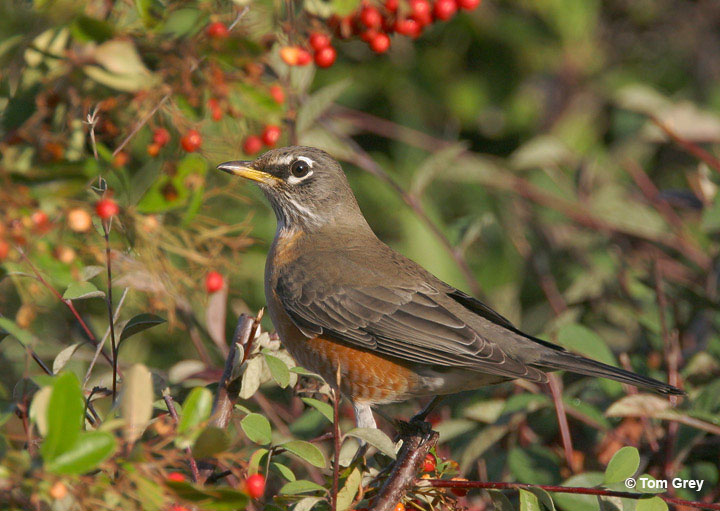
Photograph © Tom Grey
Scientific name: Turdus migratorius
Length: 10 inches
Weight: 2.7 ounces
Wingspan: 17 inches
Song: “cheery, cheery, cheery, cheery, cheer, cheer”
The American Robin is a familiar and common thrush that is dark gray above and brick red below. It also has an orange-yellow bill, a blackish head with white markings around the eyes and on the throat, and a white belly.
Both sexes of this thrush species are similar but males are darker above and more reddish on the underparts. Young American Robins have more white marks on their faces and spotting on orange underparts.
In flight, this common thrush in California also shows white corners in its outer tail feathers.
American Robins forage on the ground for worms, insects, snails, and other small creatures. In winter, these common birds flock together and perch in trees and bushes to eat berries and fruit.
The American Robin makes a cup nest in trees and lives in parks, woodlands, towns, and many other habitats. They reside in Alaska, most of Canada, the USA and in Mexico.
Key Identifications:
- Fair-sized songbird that is dark gray above, and brick red and white below.
- Forages for worms and bugs on lawns and other open grassy areas, also flocks together to feed on fruiting trees in the winter.
- Makes a cup nest in trees.
- The American Robin is quite vocal and makes a loud, sharp, “yenk!” call and quieter “check,check,check” calls. It also has a lovely cheerful song of caroled phrases, “cheery, cheery, cheery, cheery, cheer, cheer”.
The American Robin is a common, handsome thrush with dark gray upperparts and brick red and white underparts. Populations of the American Robin have been estimated at 370,000,000.
Northern Mockingbird
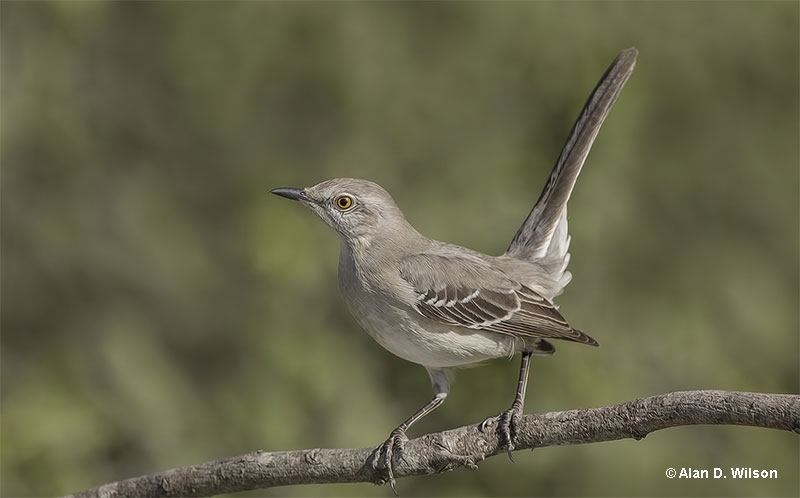
Scientific name: Mimus polyglottos
Length: 10 inches
Weight: 1.7 ounces
Wingspan: 14 inches
Song: “kerdee, kerdee, kerdee…jirdle,jirdle,jidrle…”
The Northern Mockingbird is a pale gray and white bird with a long tail. Around the same size as an American Robin, it has a dark line through a pale eye, a short, slender beak, and two white wing bars.
Both sexes look alike, are gray above, and white and buff below. In flight, this bird shows a blackish tail with white outer feathers and a big white wing patch.
Northern Mockingbirds feed on insects and berries. They forage in open grassy spots on the ground. These animated birds run and pick bugs from the ground and fly up to catch insects in flight. In winter, they also perch in bushes to feast on berries.
The Northern Mockingbird lives in towns, parks, and other semi-open habitats, and builds cup nests in bushes and low trees. Northern Mockingbirds are common garden birds in much of the eastern and southern USA, southern Ontario, and Mexico.
Key Identifications:
- Vocal, gray and white bird with a small bill, white wing patches, and a long, black and white tail.
- Feeds on the ground in open areas and in bushes. Mostly eats insects and berries.
- Makes a cup nest in a bush or low tree.
- Very vocal. Sings many phrases and mimics many other birds. Some of the more regular phrases sound like, “kerdee, kerdee, kerdee…jirdle,jirdle,jidrle…“. These are interspered with the calls of Blue Jays, woodpeckers, Tufted Titmouse, and various other bird species.
Surprisingly, this species can mimic the calls of 35 bird species as well as mechanical sounds. More than a century ago, these avian virtuosos were highly prized as a cagebird and were traded for large sums of money.
European Starling
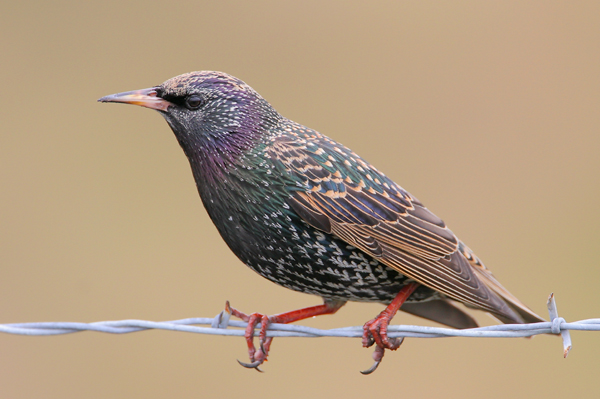
Photograph © Greg Lavaty.
Scientific name: Sturnus vulgaris
Length: 8.5 inches
Weight: 2.9 ounces
Wingspan: 16 inches
Song: “tiktiktitZHREEree..tiktiktik..ZHREE”
European Starlings are plump, short-tailed birds with long sharp beaks and longish, pointed wings. In summer, they have yellow beaks, glossy black plumage with purple and green highlights, and some small white spots.
Males and females are similar, but males have less spotting and glossier plumage. In winter, they have black beaks, white spots, and more reddish colors in their wings.
This species feeds on a variety of insects, fruit, and seeds. They can dominate bird feeders and are common species in urban areas, parks, farmlands, and other open habitats.
This European Starling builds a soft cup nest in a tree cavity, nest box, or suitable cavity in other structures.
Young starlings are shaped like adults but are grayish birds with a dark beak and a pale throat.
European Starlings flock with each other and blackbird species, especially during the winter. They live across a large part of Canada and the USA, making them one of the most common birds of California.
Key Identifications:
- Rotund, short-tailed bird with a long, sharp beak, and pointed wings. Glossy black with some spotting in the summer and blackish with heavy white spotting and streaking in the winter.
- Feeds on seeds, fruit, and insects. Visits feeders and forages on the ground in flocks.
- Builds a soft cup nest in nest boxes and other cavities.
- The European Starling makes a wide variety of mechanical and whistled sounds. They also mimic other birds and sounds in their environment. They sing long, jumbled mechanical-sounding songs, “tiktiktitZHREEree..tiktiktik..ZHREE”.
European Starlings are rounded, blackish birds with long, sharp beaks and short tails. They live in towns, cities, parks, on farms, and in other open habitats.
Nuttall’s Woodpecker
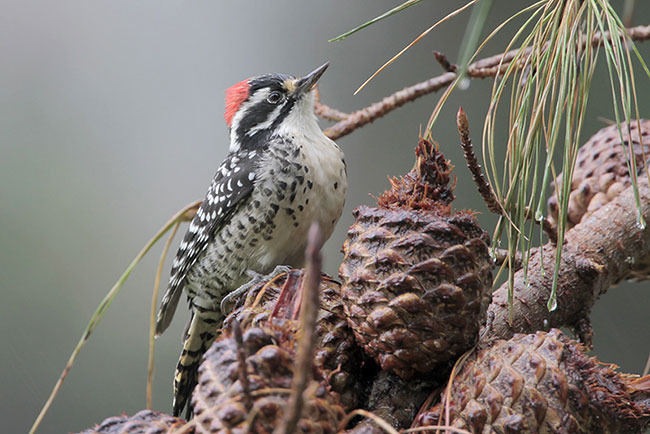
Scientific name: Dryobates nuttallii
Length: 7.5 inches
Weight: 1.3 ounces
Wingspan: 13 inches
Song: “pdip dip dip dip pdip”
The Nuttall’s Woodpecker is a small black and white woodpecker with thick black marks on its face and black and white barring on its back.
Both sexes look similar and have block spotting and barring on their sides, but males have red on the top of their head. They also have a small buff patch above their straight black beak, and a pointed black and white tail.
This woodpecker mostly feeds on insects that it picks from the bark of tree trunks and branches. It also feeds on some seeds and sap and will visit feeders for suet. They occur in pairs but don’t usually forage with other birds.
Nuttall’s Woodpeckers excavate nest cavities in the soft wood of dead trees, often, fairly high above the ground.
The Nuttall’s Woodpecker is more or less restricted to oak woodlands in California. Although they can forage in willows and other trees, they are very much associated with oaks.
Key Identifications:
- Small black and white woodpecker with barring on its back and two thick black lines on its face.
- Picks insects from the bark of tree trunks and branches. Can also visit suet feeders.
- Excavates a nest cavity in soft, dead wood.
- Makes hard and dry sounds, “pdip dip dip dip pdip”.
The Nuttall’s Woodpecker is a small black and white woodpecker species nearly restricted to oak woodlands in California. As long as oak trees are present, it can live in urban areas. This species was named after Thomas Nuttall, a 19th-century English ornithologist and botanist.
Acorn Woodpecker
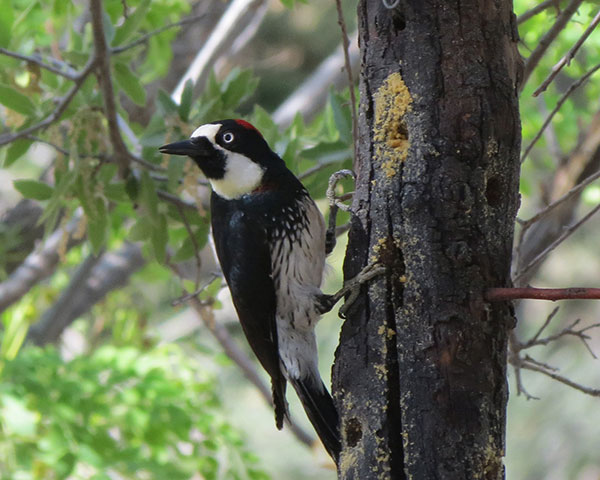
Scientific name: Melanerpes formicivorus
Length: 9 inches
Weight: 2.8 ounces
Wingspan: 17.5 inches
Song: “reh reh reh…reh heh heh!”
The Acorn Woodpecker is a medium-sized, black and white woodpecker with a bold, clown-like face and a straight, thick black beak. It has glossy black upperparts, a white rump, and a black breast.
The rest of its underparts are white with some black streaking, and it has a white patch on each wing. Both sexes have pale eyes and are similar, except males have more red on their head than females.
The Acorn Woodpecker has a diverse diet that includes insects, acorns, small animals, bird eggs, and other items. They forage by flying from a perch to catch insects in flight, and by picking up acorns and other food from foliage.
On occasion, they also visit feeders for seeds and suet.
This species nests in tree cavities and lives in oak woodlands in western Oregon and California, and Arizona, New Mexico, and western Texas. They also live in mountains from Mexico to Colombia.
Key Identifications:
- Medium-sized black and white woodpeckers with a clown-like face, solid black back, white in its wings, and some red on their head.
- Feeds on insects, acorns, and small animals.
- Excavates nest in a large tree, often in a dead limb.
- Very vocal, makes rattling, laughing calls, “reh reh reh…reh heh heh!”.
The Acorn Woodpecker is a loud and obvious, boldly marked, black and white woodpecker of oak woodlands. This very social bird lives in noisy family groups that catch insects in flight and gather acorns. Acorn Woodpeckers store acorns in small holes made in trees and other wooden structures and can make as many as 50,000 holes in one tree!
Oak Titmouse
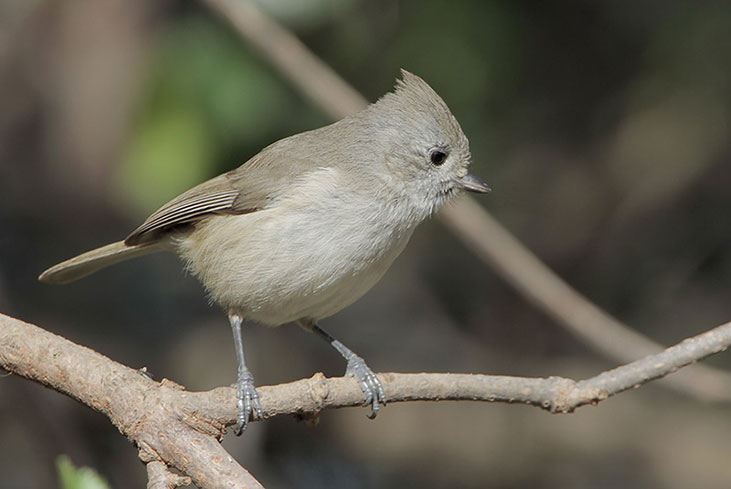
Scientific name: Baeolophus inornatus
Length: 5.75 inches
Weight: .6 ounces
Wingspan: 9 inches
Song: “treecuh treecuh…treecuh treecuh”
The Oak Titmouse is a small, gray, crested bird with a stout and stubby beak. Males and females look alike, are around the size of a sparrow, have some buff on their underparts, and beady black eyes.
This small, plain bird feeds on a wide variety of seeds and insects. It forages by picking food items from bark and foliage, although it can also do some feeding on the ground. While foraging, they often call and hang upside down from twigs.
They often occur in small groups or with flocks of other small birds and visit feeders in gardens in and or near woodlands.
Related: Tit species (including titmice & chickadees)
The Oak Titmouse uses moss, grass, hair, and feathers to make a shallow cup nest inside a tree cavity.
This species is more or less restricted to oak woodlands and oak-pine forests in California. Small populations also occur in southern Oregon and parts of Baja California, Mexico.
Key Identifications:
- Small plain gray bird with a crest, stout and stubby beak, and beady black eyes.
- Feeds on seeds and insects in oak woodlands and also visit feeders.
- Makes a shallow nest inside a tree cavity.
- Vocal and often makes double whistled calls over and over, “treecuh treecuh…treecuh treecuh.”
The Oak Titmouse is a small, crested gray bird with a short and stout beak. This species is often seen in pairs or groups that forage with flocks of other small birds. The Oak Titmouse is very similar to the Juniper Titmouse but was split from that species when studies showed that their DNA, songs, and habitat were very different.
Canada Goose
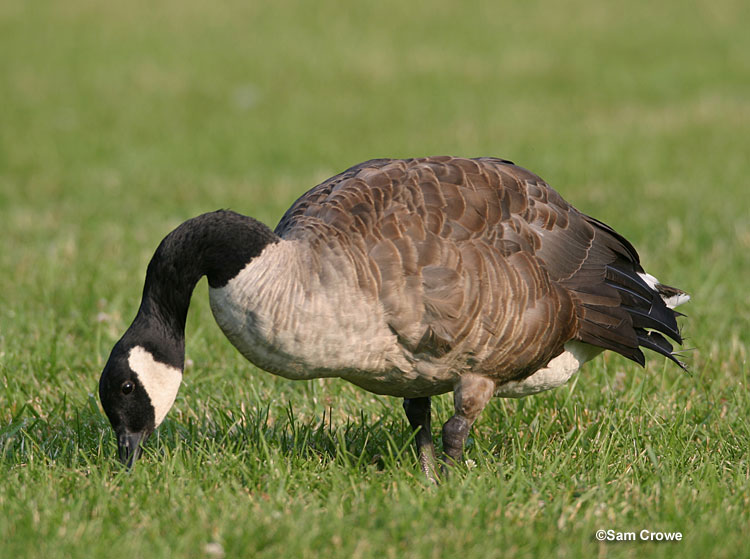
Scientific name: Branta canadensis
Length: 35 – 45.2 inches
Weight: 5.29 – 19.8 pounds
Wingspan: 50 – 67 inches
Song: “uurrRUNK! uurrRUNK!”
The Canada Goose is a large, grayish-brown bird with a long black neck, and black head with a white throat and cheeks. Males and females look alike and have pale barring, a white belly and undertail, and a short black and white tail.
They have strong direct flight and make deep flaps with long, broad wings.
Canada Geese feed on grass, sedges, and other vegetation, grain, and berries. They forage by walking along and grazing, or picking food from the ground and bushes. This species also feeds by dipping its head below the surface of shallow water.
This large goose uses grass and other plants to make a large, shallow cup nest on a small mound or other elevated spots next to water.
The Canada Goose prefers open grassy areas and farm fields near water where it can feed and see predators before they get too close. They live in Alaska, most of Canada, and most of the USA, being one of the most common birds of California.
Key Identifications:
- Big, gray-brown goose with a long black neck, and black and white head.
- Grazes vegetation and forages for berries in wide open, grassy habitats near water like golf courses, parks, and airports.
- Makes a shallow, open cup nest on an elevated spot next to water.
- Vocal and often makes honking calls, “uurrRUNK! uurrRUNK!”.
Canada Geese are a large, common goose species with long black necks, and a black and white head. These big birds are a common sight on golf courses and other places that combine open lawns and water. When the Canada Goose and other birds migrate in “V” formation, they expend less energy than flying on their own.
Western Bluebird
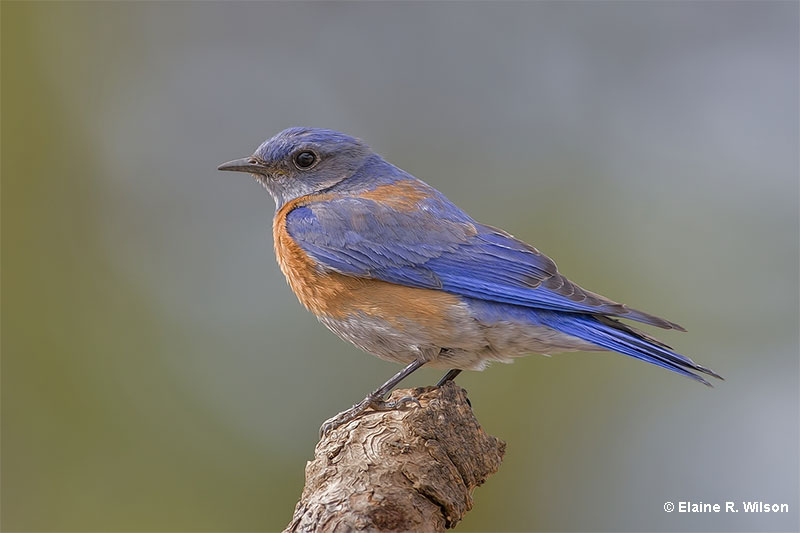
© Elaine R. Wilson
Scientific name: Sialia mexicana
Length: 7 inches
Weight: 1 ounces
Wingspan: 13.5 inches
Song: “fer fer chidip fer”
The Western Bluebird is a smallish, beautiful blue and gray bird with a chestnut patch on its back and deep pumpkin orange on its breast and upper flanks. The male has a deep blue head, back, wings, and tail, while females are paler, grayer, and have a white eyering.
Young birds are more gray-brown with pale spotting. This species also has long wings that it uses for quick, swooping flight.
The Western Bluebird feeds on insects, small fruit, and some seeds. It catches insects in flight, by picking them from foliage, and by swooping down into meadows and catching them on the ground.
They feed on berries and other small fruits by picking them from vegetation while they are perched.
Western Bluebirds build a shallow cup nest out of grass inside a tree cavity.
These beautiful birds live in pine and oak woodlands with meadows in south-central British Columbia and various parts of the western USA south to Mexico.
Key Identifications:
- Smallish blue and gray birds with chestnut on their back and deep orange on their breast and flanks.
- Feeds on insects and small fruits.
- Makes a shallow cup nest out of grass in a tree cavity.
- Makes short calls, “fer fer chidip fer”.
The Western Bluebird is a smallish, blue and gray bird with deep orange highlights. They live in semi-open woodlands and, in winter, form flocks that visit fruiting trees. Western Bluebirds are cooperative breeders that can help feed each other’s young.
Double-crested Cormorant
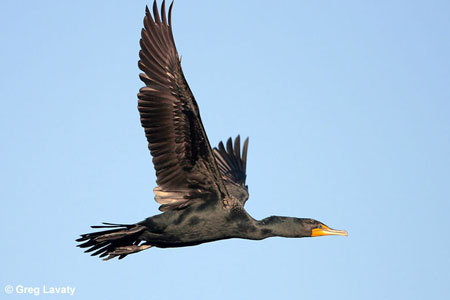
Scientific name: Nannopterum auritum
Length: 33 inches
Weight: 3.7 pounds
Wingspan: 52 inches
Song: “groak”
The Double-crested Cormorant is a big, glossy black bird with a long, thick neck. Males and females look alike and also have a medium-length beak with a sharp, hooked tip, an orange throat patch, and a bit of orange on the face.
Double-crested Cormorants have a short, wispy crest, green eyes, broad tail, and big webbed feet. They use their long wings to flap and glide with direct flight between feeding and roosting areas.
This highly aquatic species feeds on fish. It catches its food by diving, swimming beneath the water, and then snatching a fish with its beak. It eats the fish while perched above the water.
The Double-crested Cormorant breeds in colonies and makes a messy stick nest in a tree on an island or above the water. We see this bird in parts of central and southern Canada, in much of the USA, and in parts of Mexico and the Caribbean.
Key Identifications:
- Big, nearly goose-sized black bird with a long, thick neck, and a medium-length narrow beak with a small, hooked tip. It also has a rectangular, orange throat patch.
- Forages by floating and then diving beneath the water. Swims underwater to catch fish with its beak.
- Breeds in colonies and constructs a messy stick nest in trees on islands, or over water.
- Double-crested Cormorants aren’t very vocal. They make some low, guttural, pig-like sounds at their breeding colonies, “groak”.
The Double-crested Cormorant is a large, black bird with a long, thick neck and an orange throat patch. It often occurs in flocks that frequent lakes, rivers, and other wetlands. When it comes to fish, this species is not a picky eater; it has been documented eating more than 250 species.
American Coot
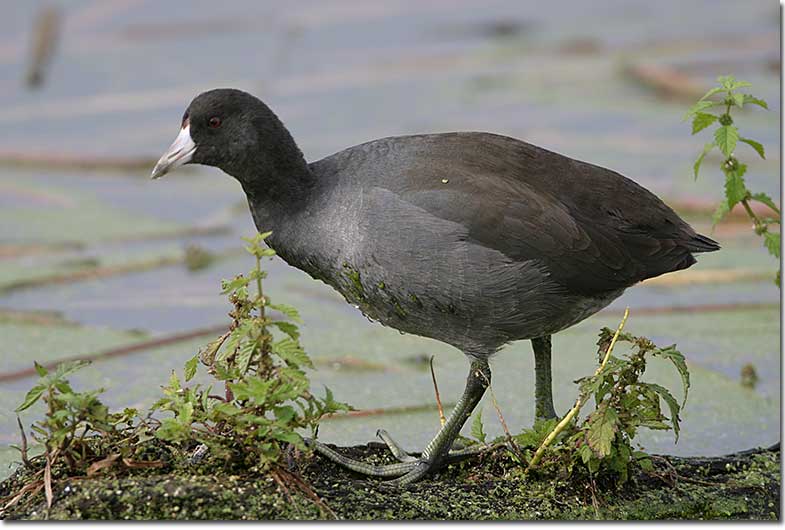
American Coot
Scientific name: Fulica americana
Length: 15.5 inches
Weight: 1.4 pounds
Wingspan: 24 inches
Song: “reah reah rik rik cluck cluck cluck”
The American Coot is a blackish, duck-like bird with reddish eyes, and small dark marks near the tip of its stubby, chalky white beak. Males and females look the same and have short tails with a bit of white, and greenish-yellow legs with semi-webbed toes.
In flight, this species shows a narrow white line on the trailing part of its rounded wings. Young birds are like adults but are more dull, grayish overall.
American Coots feed on aquatic plants and small aquatic insects. They can also forage on land for corn and other types of grain but mostly pick vegetation from the surface of the water while floating. Like ducks, they also dip below the water to feed.
This species uses aquatic plants to make a floating nest in marsh vegetation.
American Coots live on lakes, ponds, and shallow marsh habitats in many parts of Canada and the USA south to the Caribbean and Central America.
Key Identifications:
- Duck-sized blackish aquatic bird with a stubby white beak.
- Feeds on aquatic plants, grain, some insects, and some small aquatic creatures.
- Makes a floating nest from marsh vegetation.
- A vocal bird that makes lots of odd growling and clucking sounds like “reah reah rik rik cluck cluck cluck.”
The American Coot is a dark, duck-like aquatic bird with a stubby white beak. It feeds on aquatic vegetation and insects in lakes, marshes, and other shallow-water habitats. When coots fly, they run on the water while quickly flapping their wings to become airborne.
Western Gull
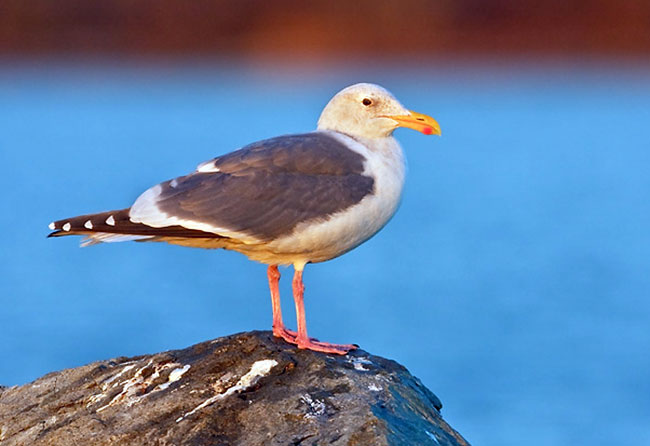
Scientific name: Larus occidentalis
Length: 25 inches
Weight: 2.2 pounds
Wingspan: 58 inches
Song: “ruh rih REH REH REH REH REH”
The Western Gull is a large gull with white head and body, pink legs, and dark gray back and wings. Its wings also have black tips with small white spots, and it has a strong, deep orange-yellow beak with a small red spot.
Young birds can be uniform brownish with a black tail, mostly black bill, and paler grayish rump. As they get older, they look more like adults but have a black and yellow beaks.
These large gulls feed on a wide variety of items in coastal habitats. They are opportunistic and can eat fish, carrion, small animals, garbage, and other items.
Western Gulls nest in colonies on islands and other inaccessible spots on the Pacific coast. Their nest is made up of bits of vegetation in a scrape on the ground, usually next to a rock or log.
This species lives on the Pacific coast and is one of the most common birds of California.
Key Identifications:
- Large gull of the Pacific coast with a dark gray back and wings.
- Feeds on carrion, small animals, fish, and other bits of food it finds on beaches.
- Breeds in colonies and makes a scrape nest on the ground with bits of vegetation.
- Makes a loud, laughing call, “ruh rih REH REH REH REH REH”.
The Western Gull is a large gull with a dark gray back and wings. It only lives on the Pacific coast of North America and patrols beaches for various bits of food. This species is a very opportunistic feeder that even takes milk from sleeping seals!
Northern Flicker
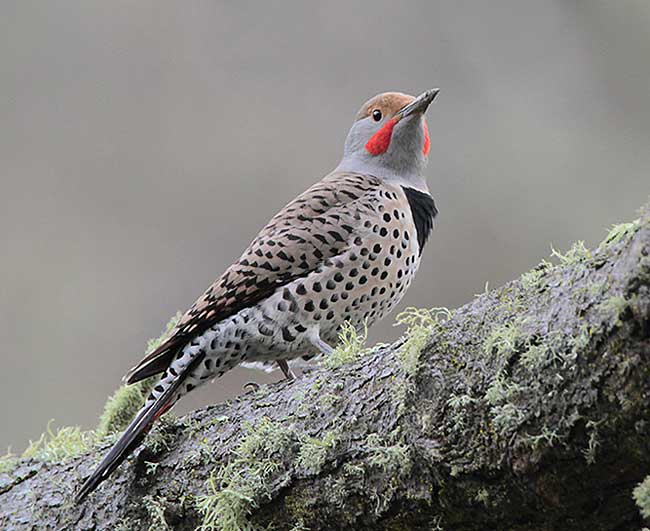
Scientific name: Colaptes auratus
Length: 12.5 inches
Weight: 4.6 ounces
Wingspan: 20 inches
Song: “kick,kick,kik,kik,kik.kik.kik.kik.kik.kik.kik.kik!”
Northern Flickers are fairly large, tan and gray woodpeckers with barring on their backs. They have a black mark on their breast, black spotting below, and a dark, stout beak.
Males in the east have a tawny throat and face with a black mustache and small red spots on the back of their heads. Males in the west have mostly gray heads with a red mustache.
Female Northern Flickers look like males but lack the mustache mark.
In bounding flight, they have white rumps and flash color on their underwings. This is bright yellow in eastern birds and reddish in flickers west of the Rocky Mountains.
This woodpecker eats many ants and other insects that it catches on the ground. It forages by flying to the ground, locating anthills, and lapping them up with its long tongue.
Northern Flickers nest in tree cavities and live in wooded and open habitats in Canada, the USA, and Mexico.
Key Identifications:
- Tan and gray woodpecker with black barring above, black marks below, and a bright, white rump.
- Forages for ants and other insects on the ground.
- Nests in tree cavities.
- A vocal woodpecker, the Northern Flicker often gives loud, “flicka,flicka,flicka” calls and another loud, single note that sounds like, “Keer!” They also have a long, laughing vocalization of repeated notes, “kick,kick,kik,kik,kik.kik.kik.kik.kik.kik.kik.kik!”.
Northern Flickers are fairly big, tan woodpeckers with gray highlights, a white rump, and black markings. They mostly forage for ants on the ground in open and wooded areas. The red-shafted Northern Flickers in the west used to be considered a separate species from the yellow-shafted flickers of the east. At present, they are considered to be one species because they frequently hybridize with each other.
Great Egret
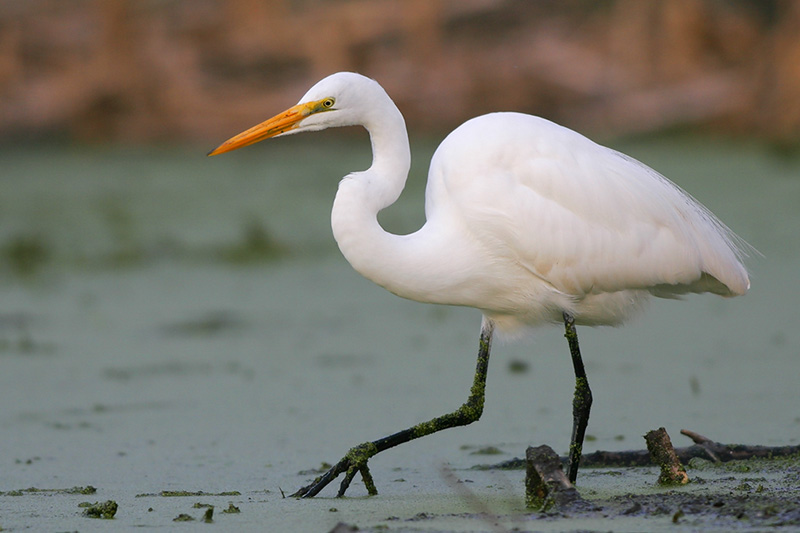
Photograph © Greg Lavaty.
Scientific name: Ardea alba
Length: 39 inches
Weight: 1.9 pounds
Wingspan: 51 inches
Song: “koorr”
The Great Egret is a big, white heron with a long neck, and long dark legs and feet. Both sexes look similar and have long, sharp yellow beaks, and pale eyes.
In breeding season, they have long, elegant white plumes on their backs and greenish skin in front of their eyes.
In flight, this large waterbird shows long, broad wings and a short, broad tail. Its legs trail out behind it, and the bird holds its neck tucked in.
Great Egrets feed on fish, frogs, snakes, and other small animals that venture too close, birds and rodents included. They wade in or near water and then wait until prey comes close. If the animal approaches within range, they quickly catch it with their long, sharp beak.
The Great Egret nests in colonies and builds a big, messy, stick nest. It is common in wetlands in much of the USA, parts of southern Canada, and many other parts of the world.
Key Identifications:
- Big white bird with a long neck, yellow beak, and dark legs and feet.
- Feeds in and near wetlands, on the ground. Catches fish and small animals with its long, sharp beak.
- Makes bulky stick nests in colonies.
- Great Egrets make deep, croaking sounds, especially when taking flight. “koorr…koorr“
The Great Egret is a common and conspicuous bird in wetland habitats. It can be seen alone or in groups taking advantage of an easy food source.
Great Blue Heron
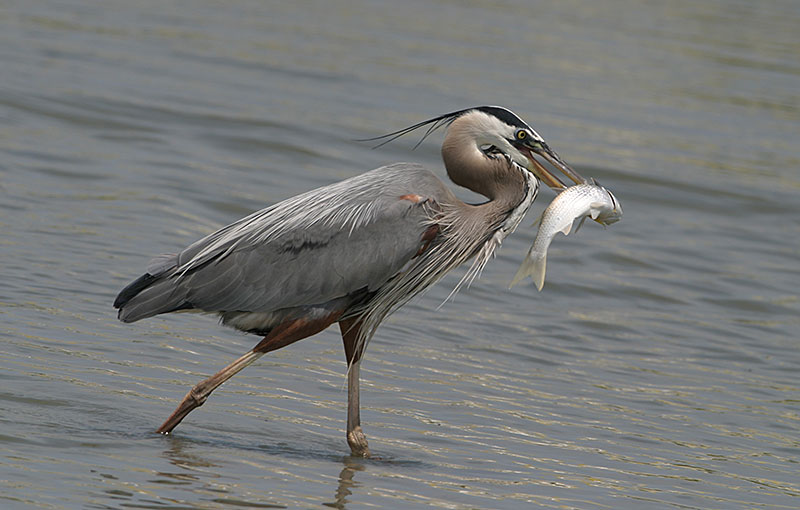
Great Blue Heron
Scientific name: Ardea herodias
Length: 46 inches
Weight: 5.3 pounds
Wingspan: 72 inches
Song: “Grunk! Grunk!”
The Great Blue Heron is a large, gray and pale brown heron with a long neck and legs. It has a strong, yellowish beak, black and white head with a wispy black crest, and rufous thighs.
Both sexes are alike and have pale bellies and black flanks. Juveniles have streaked underparts.
In flight, they make slow, deep flaps with long, broad gray and black wings. In Southern Florida and the Caribbean, Great Blue Herons are all white and sometimes considered a separate species, the “Great White Heron.”
These powerful herons feed on fish and small animals such as rats, snakes, and birds. They wade in and near water, wait, and then quickly catch prey with their sharp beaks.
Great Blue Herons build messy, stick nests and breed in colonies, often in swamps.
We find these impressive birds in and near a wide variety of wetlands in large parts of Canada, the USA, including California.
Key Identifications:
- Huge gray and pale brown wading bird with a thick, yellowish beak and a wispy crest. In southern Florida, it is all white but still has a crest and a strong yellowish beak.
- Stalks and preys on fish and small animals.
- Builds messy stick nests and breeds in colonies.
- Great Blue Herons aren’t all that vocal. When taking flight, they make a croaking sound, “Grunk! Grunk!“.
The Great Blue Heron occurs on rivers, lakes, and many other wetlands. It stands still for long periods of time while waiting for prey to come within range of its sharp beak but is also often seen in flight.
Ruby-crowned Kinglet
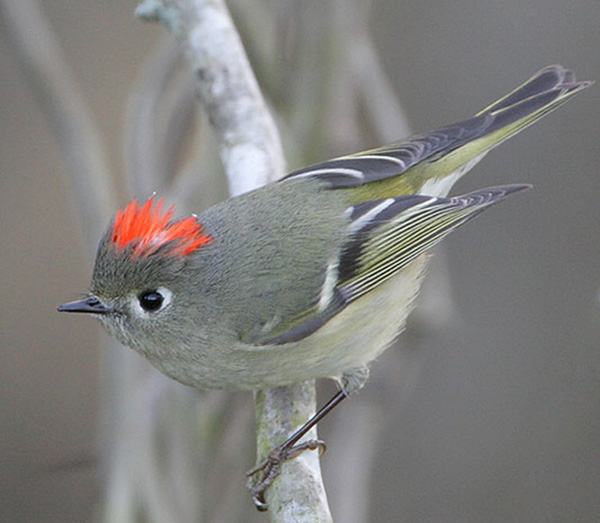
Photograph © Greg Lavaty.
Scientific name: Regulus calendula
Length: 4.25 inches
Weight: .23 ounces
Wingspan: 7.5 inches
Song:“seetseetseet, reardidehdidid, ridiDEEP,ridiDEEP,ridiDEEP!”
Ruby-crowned Kinglets are tiny, grayish-olive birds with small, slender beaks. They have a broken white eyering and dark wings with yellowish-white edging on their feathers.
Both sexes look very similar and also have two white wing bars, the lower wing bar much more obvious than the upper one. Males also have a hidden, bright red or orange crest revealed in displays and aggressive situations.
The Ruby-crowned Kinglet is an active bird that rarely sits still. It feeds on small bugs, spiders, and insect eggs that it finds in conifers, bushes, and trees. They can forage at any height, often hover to pick food off foliage, and usually occur in flocks with other small birds.
Ruby-crowned Kinglets breed in coniferous forests in Alaska, Canada, parts of the northern USA, and the western USA. They spend the winter in parks and woodlands in much of the eastern, southern, and western USA (including California), and Mexico.
Key Identifications:
- Tiny, grayish-olive bird with a broken eyering, two pale wing bars (the lower one more obvious), and a hidden red crest.
- Feeds on small arthropods and insect eggs in bushes and trees.
- Makes a small, rounded cup nest out of moss, lichens, and other soft materials high in spruce or other conifer.
- Sings a cheerful and surprisingly loud, “seetseetseet, reardidehdidid, ridiDEEP,ridiDEEP,ridiDEEP!”.
The Ruby-crowned Kinglet is a tiny insectivorous bird that breeds in northern and montane coniferous forests and winters in a variety of wooded habitats. It is very active and usually forages with other small birds. The female Ruby-crowned Kinglet can lay 12 eggs in one nest!
Red-winged Blackbird
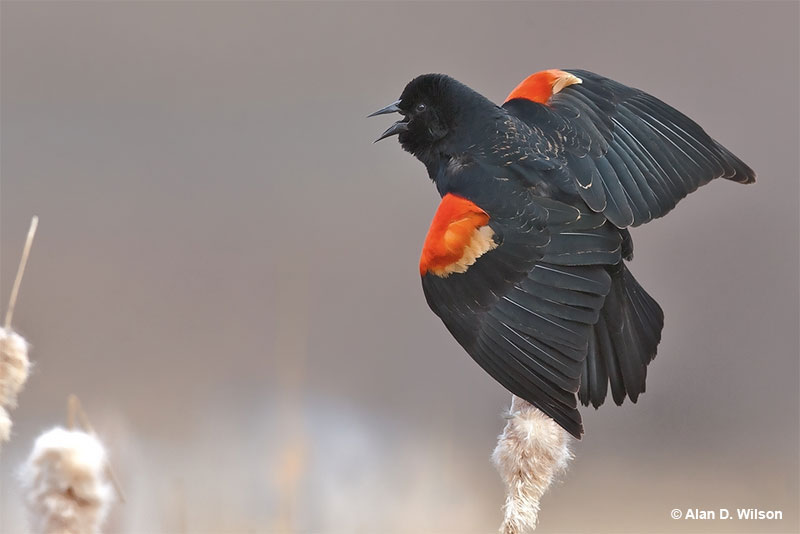
Scientific name: Agelaius phoeniceus
Length: 8.75 inches
Weight: 1.8 ounces
Wingspan: 13 inches
Song: “kan-keree!”
The Red-winged Blackbird is a medium-sized blackbird species with a sharp, all-black bill. Males also have a scarlet patch with a pale yellow border on the shoulder of each wing.
Female Red-winged Blackbirds are dark, heavily streaked, brownish-gray birds with an orange-buff eyebrows and throat. She can also have a little bit of dingy red on her shoulder.
Red-winged Blackbirds often flock together and can form very large groups in the winter. They feed on seeds, grain, and insects found on lawns, in marshes, farm fields, and other open habitats.
This species builds a cup nest made of leaves and dead stems in a bush or other low vegetation in a marsh, park, or brushy field.
Red-winged Blackbirds are very common birds that live in all sorts of open habitats. We see them in parks, farming areas, and marshes in much of Canada, the USA, making them one of the most common birds of California.
Key Identifications:
- Males are medium-sized blackbirds with bright red patches on their wings. Females are heavily streaked, have a sharp black beak, and buff on the head.
- Feeds on seeds, grain, and insects on the ground in many open habitats.
- Builds a cup nest in a bush or other low vegetation.
- Red-winged Blackbirds often call. Males sing a loud “kan-keree!” and both sexes also make “check!” calls and a high-pitched whistle-like sound.
The Red-winged Blackbird is a common, social species easily seen in marshes and open habitats. In the winter, it can form huge flocks that feed in farm fields. This species can make a daily commute of 50 miles to and from roosting and feeding sites.
Birds of California – Frequently Asked Questions
How many bird species are native to California?
In total, 684 bird species are native to California. There are 684 birds on the official California bird list.
What is the most common bird in California?
The most common bird in California is the House Finch. Data in eBird show more sightings of this species than any other bird.
What is the largest bird in California?
The largest bird in California is the American White Pelican. This big pelican species has a wingspan of nine feet and a length of 62 inches. Another strong contender for the largest bird in California is the California Condor. The wingspan of this huge vulture species is a little bit bigger than the pelican, and it weighs 23 pounds.
What is the smallest bird in California?
The smallest bird in California is the Calliope Hummingbird. This smallest hummingbird in the USA is 3.25 inches long.
What is the fastest bird in California?
The fastest bird in California is the Peregrine Falcon. This falcon is the fastest bird in the world and reaches speeds of 200 miles per hour!
More in California: Hawks | Owls | Ducks | State Bird

